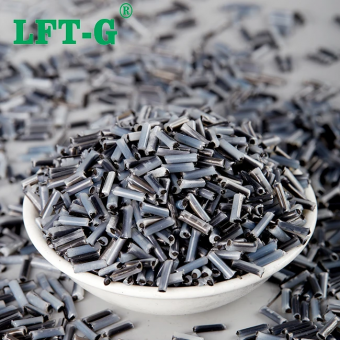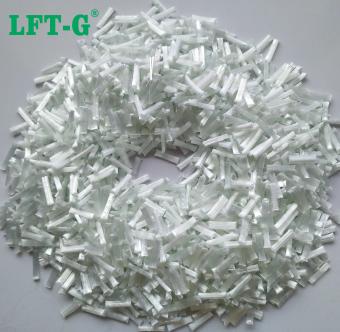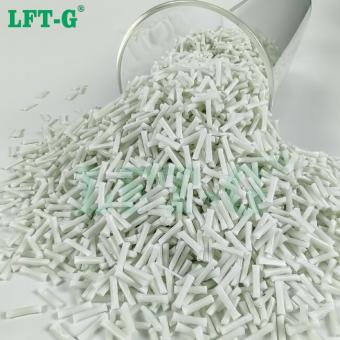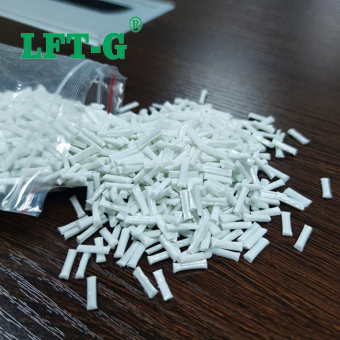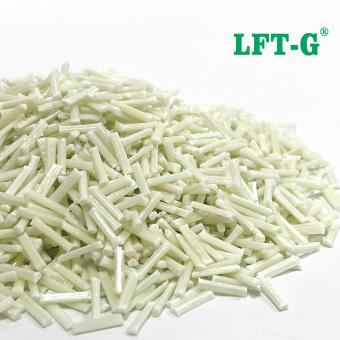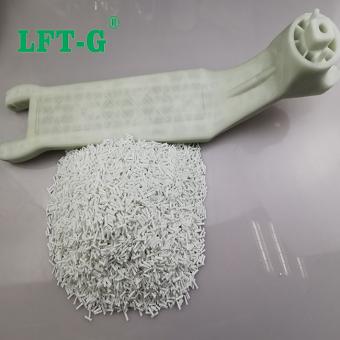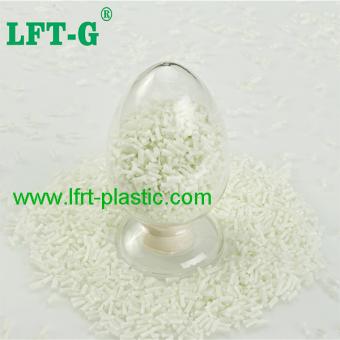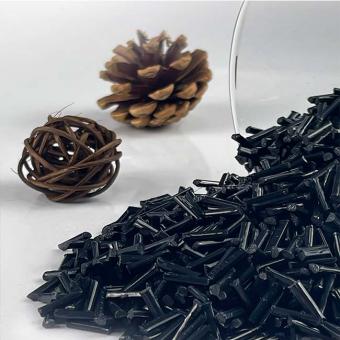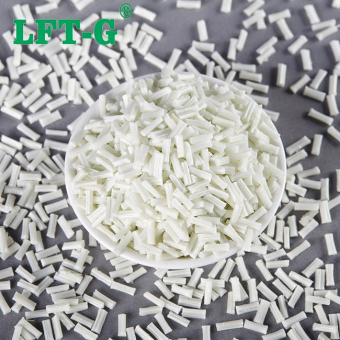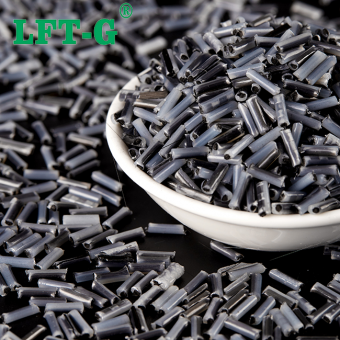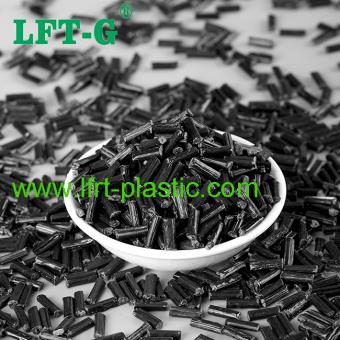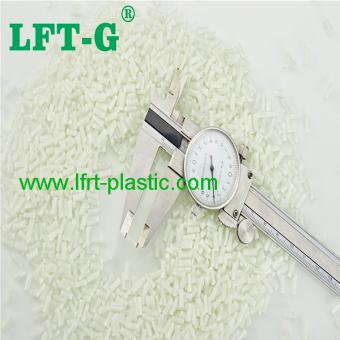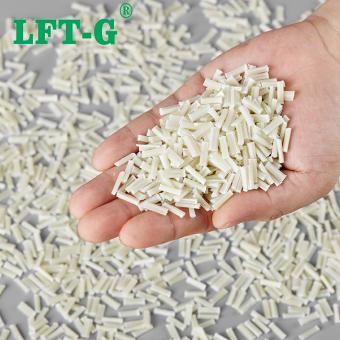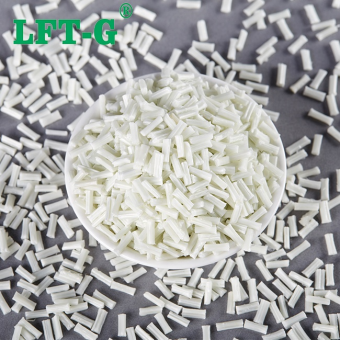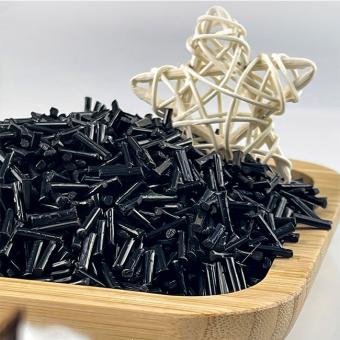-
Marca LFT-G PA6 Poliamida6 nylon6 relleno fibra de vidrio larga40 color original para piezas de automóviles¿Qué es el plástico PA6? La poliamida (PA), generalmente llamada nailon, es un polímero de heterocadena que contiene un grupo amida (-NHCo -) en la cadena principal. Se puede dividir en grupo alifático y grupo aromático. Es el material de ingeniería termoplástico desarrollado más temprano y más utilizado. La cadena principal de poliamida contiene muchos grupos amida repetidos, se usa como un plástico llamado nailon, se usa como una fibra sintética llamada nailon. Se puede preparar una variedad de poliamidas diferentes según el número de átomos de carbono contenidos en aminas binarias y ácidos dibásicos o aminoácidos. En la actualidad existen decenas de poliamidas, entre las cuales la poliamida-6, la poliamida-66 y la poliamida-610 son las más utilizadas. La poliamida-6 es una poliamida alifática, con peso ligero, fuerte resistencia, resistencia al desgaste, resistencia débil a ácidos y álcalis y algunos solventes orgánicos, fácil moldeo y procesamiento y otras propiedades excelentes, ampliamente utilizada en fibra, plásticos de ingeniería y películas delgadas y otros campos. , pero el segmento de la cadena molecular PA6 contiene grupos amida de polaridad fuerte, enlaces de hidrógeno fáciles de formar con moléculas de agua, el producto tiene las desventajas de una gran absorción de agua, poca estabilidad dimensional, baja resistencia al impacto en estado seco y baja temperatura, fuerte resistencia a ácidos y álcalis . Advantages of nylon 6: High mechanical strength, good toughness, high tensile and compressive strength. Outstanding fatigue resistance, the parts after repeated bending can still maintain the original mechanical strength. High softening point, heat resistant. Smooth surface, small friction coefficient, wear-resistant. Corrosion resistance, very resistant to alkali and most salts, also resistant to weak acids, oil, gasoline, aromatic compounds and general solvents, aromatic compounds are inert, but not resistant to strong acids and oxidants. It can resist the corrosion of gasoline, oil, fat, alcohol, alkaline and so on, and has good anti-aging ability. It is self-extinguishing, non-toxic, odorless, good weather resistance, inert to biological erosion, and has good antibacterial and mildew resistance. Has excellent electrical performance, good electrical insulation, nylon volume resistance is high, high breakdown voltage resistance, in dry environment, can work frequency insulation material, even in high humidity environment still has good electrical insulation. Light weight, easy dyeing, easy forming, because of low melting viscosity, can flow quickly. Disadvantages of Nylon 6: Easy to absorb water, water absorption, saturated water can reach more than 3%. Poor light resistance, in the long-term high temperature environment will oxidize with oxygen in the air, the color turns brown at the beginning, and the subsequent surface is broken and cracked. Injection molding technology requirements more strict, the existence of trace moisture will cause great damage to the quality of molding; The dimensional stability of the product is difficult to control because of thermal expansion. The existence of sharp Angle in the product will lead to stress concentration and reduce the mechanical strength; If the wall thickness is not uniform, it will lead to the distortion and deformation of the parts. High precision of equipment is required in post-processing. Will absorb water, alcohol and swelling, not resistant to strong acid and oxidant, can not be used as acid-resistant materials. Why filling Long Glass Fiber? PA6 has excellent properties such as light weight, strong strength, abrasion resistance, weak acid and alkali resistance and some organic solvents, and easy molding and processing. It is widely used in the fields of fibers, engineering plastics and films. However, the molecular chain segment of PA6 contains highly polar amide groups, which are easy to form hydrogen bonds with water molecules. The product has the disadvantages of large water absorption, poor dimensional stability, low impact strength in dry state and low temperature, strong acid and alkali resistance. With the development of science and technology and the improvement of life quality, the defects in some properties of traditional PA6 materials have limited its development in some fields. In order to improve the performance of PA6 and expand its application field, PA6 should be modified. Filling enhancement modification is a common method for physical modification of PA6. It refers to the modification of PA6 by adding fillers such as glass fiber and carbon fiber into the matrix to significantly improve the mechanical properties, flame retardant properties, thermal conductivity and dimensional stability of the material. What is application of PA6-LGF? Modified section of 30% long glass fiber reinforced PA6 is the ideal material for processing power tool shell, power tool parts, engineering machinery parts and automobile parts. Its mechan...
- Compuesto de poliamida 6
- resina termoplástica lgf
- PA6 de alto impacto
- moldeo por inyección de plástico
- pa6 relleno de fibra de vidrio largo
- Plástico reforzado
Etiquetas :
-
Xiamen lft poliamida6 plástico reforzado con fibra de vidrio larga alta dureza ligero 12mmPA66 filling LGF Nylon (PA) has a series of excellent properties, such as high mechanical strength, chemical resistance, oil resistance, wear resistance, self-lubrication, easy processing and forming, and has become one of the thermoplastic engineering plastics widely used at home and abroad. Pero en la aplicación práctica, los requisitos de rendimiento del nailon son diferentes en diferentes condiciones o entornos. Por ejemplo, el taladro eléctrico y la carcasa del motor, el impulsor de la bomba, el cojinete, el motor diésel y el ventilador del aire acondicionado y otras piezas requieren que el material de nailon tenga alta resistencia, alta rigidez y alta estabilidad dimensional; Debido a la escasa tenacidad del nailon a baja temperatura, es necesario endurecerlo. En algunas aplicaciones al aire libre, los materiales de nailon deben ser modificados resistentes a la intemperie en un entorno exterior a largo plazo. Los materiales reforzados utilizados para el nailon son principalmente fibra de vidrio, fibra de carbono, bigotes y otros materiales fibrosos, y el reforzado con fibra de vidrio es el más utilizado. El refuerzo de fibra de vidrio obviamente puede mejorar la rigidez, la resistencia y la dureza del material, y obviamente se mejoran la estabilidad dimensional y la resistencia al calor del material. Debido a que el nailon en sí mismo no es lo suficientemente fuerte, al agregar del 10 al 30 por ciento de la fibra, se aumenta su resistencia. En particular, una fuerza del 30% se considera la proporción más apropiada. También agregado al 40-50%, de acuerdo con los requisitos específicos de los diferentes productos, junto con la fórmula adecuada, puede tener éxito. Tecnología de producción de nailon reforzado con fibra de vidrio. Método de fibra larga, es decir, el nylon y otros componentes se mezclan previamente y se agregan a la tolva, y la fibra de vidrio de la entrada de fibra de vidrio a través del tornillo gira en el tornillo y luego se mezcla con resina de nylon. Factores que afectan las propiedades del nylon reforzado con fibra de vidrio En primer lugar, la unión de interfaz entre la fibra de vidrio y la resina de nailon tiene el efecto más importante en el nailon reforzado con fibra de vidrio. Si la combinación entre ambos no es buena, el efecto de refuerzo se verá muy reducido. En este momento, el tratamiento superficial de la fibra de vidrio es particularmente importante. Hoy en día, los fabricantes de fibra de vidrio han sido capaces de producir modelos de fibra de vidrio para diferentes materiales con diferentes tratamientos de superficie para uso de los fabricantes de plásticos modificados, siempre y cuando sea la elección correcta. En segundo lugar, la longitud de la fibra de vidrio en el material de nylon es otro factor importante que afecta sus propiedades. En general, las fibras de vidrio largas son superiores a las fibras de vidrio cortas en términos de resistencia a la tracción, resistencia y módulo de flexión, y resistencia al impacto con muescas. Al mismo tiempo, no se puede ignorar la dispersión de fibra de vidrio en el material. La dispersión de la fibra de vidrio depende principalmente de la acción de corte adecuada del tornillo doble y de la acción de amasado del material, lo que implica la combinación y la velocidad del tornillo. La selección de la velocidad del tornillo está relacionada con el contenido de aditivos como la fibra de vidrio en la fórmula. Para el nailon reforzado con retardante de llama, la velocidad baja es adecuada porque el retardante de llama se ha descompuesto por el calor. Además, la temperatura de procesamiento, el diámetro de la fibra de vidrio y el tipo de fibra de vidrio también afectarán el rendimiento final del material, por lo que no se repetirá aquí. La fibra de vidrio mejora la fluidez del nailon. La fluidez del nailon reforzado con fibra de vidrio es pobre, y es fácil que ocurran problemas como alta presión de inyección, alta temperatura de inyección, insatisfacción con el moldeo por inyección y mala calidad de la superficie en el proceso de moldeo por inyección, lo que afecta seriamente la apariencia de los productos y el plomo. a una alta tasa de defectos de los productos. Especialmente en el proceso de producción de productos de moldeo por inyección, y no se puede agregar lubricante directamente para resolver el problema, solo se puede mejorar la materia prima, en términos generales, esto debe agregarse en los componentes de lubricación de fórmula modificada. Resistencia del nailon reforzado con fibra de vidrio al calor a alta temperatura y al envejecimiento por oxígeno En algunas aplicaciones, como rodamientos y ventiladores diésel, el nailon reforzado con fibra de vidrio a menudo se enfrenta al problema del envejecimiento térmico y por oxígeno a altas temperaturas durante mucho tiempo. Aunque la modificación reforzada del nailon con fibra de vidrio puede mejorar moderadamente la resistencia al calor del nailon, no puede resolver bien el probl...
- plástico de nailon pa66
- Poliamida66 fibra de vidrio larga
- pa66 llenar gf
- materia prima plastico pa66
- materiales compuestos pa66
- resina termoplástica
Etiquetas :
-
Marca PA6 LFT-G composite fibra larga de carbono poliamida 6 para fabricación de cascosMateria prima PA6 La poliamida 6, también conocida como policaprolactama o nailon 6 (PA6), es una resina termoplástica semitransparente a opaca de color amarillento o blanco lechoso. La densidad relativa de PA6 es de 1,12~1,14g/cm3, el punto de fusión es de 219~225℃, la resistencia a la tracción es de 68~83MPa, la resistencia a la compresión es de 82~88MPa, la resistencia a bajas temperaturas es buena (-75℃ no es frágil), la resistencia al desgaste, la autolubricación y la resistencia al aceite son buenas. Due to the excellent structure and properties of PA6, more and more researchers at home and abroad have carried out important research and development on PA6, including exploring new polymerization chemicals for production, changing its structure and properties, and finding new processing methods, etc. PA6-LCF Long carbon fiber (LCF) reinforced nylon composites with high specific strength, high specific modulus, high temperature resistance and other excellent properties, expand the application space of nylon high technology field, is one of the most important reinforced composites at present. TDS Tested by us, for reference only. Application Injection technology About us Come and contact us now!
- Fibra de carbono larga PA6
- PA6 LCD
- Materiales compuestos de nailon 6
- moldeo por inyección de plástico industrial
- resina PA6
- plástico compuesto
Etiquetas :
-
PA66 Polyamide66 fibra de carbono larga lcf llena de negro natural hecha en China de alta calidadPA66 Nylon (PA) has a series of excellent properties, such as high mechanical strength, chemical resistance, oil resistance, wear resistance, self-lubrication, easy processing and forming, and has become one of the thermoplastic engineering plastics widely used at home and abroad. But in the practical application, the performance requirements of nylon are different under different conditions or environment. For example, electric drill and motor shell, pump impeller, bearing, diesel engine and air conditioning fan and other parts require nylon material to have high strength, high rigidity and high dimensional stability; Because of the poor toughness of nylon at low temperature, it is necessary to toughen it. In some outdoor applications, nylon materials must be weather-resistant modification in long-term outdoor environment. PA66-LCF Long carbon fiber reinforced nylon has excellent damping properties in 3D printing and has better performance than glass fiber reinforced nylon. In the design of tools for industrial applications, traditional techniques have used aluminum or alternative metal alloys because metal components perform better and meet the requirements of the tool. In many cases, thermoplastics can meet the strength requirements of such tools, but not the rigidity requirements for performing test tasks. Carbon fiber reinforced nylon is an ideal substitute for metal. Due to the combination of the light weight of nylon and the mechanical strength and thermal properties of carbon fiber, the strength and stiffness of carbon fiber composite nylon material is significantly improved, and its mechanical strength even exceeds that of 3D-printed PEEK and PEKK. In the automobile industry, from internal and external components such as vehicle anchors and instruments to engine housing, metal parts can be replaced. As we all know, automotive carbon fiber is widely used in automobile manufacturing due to its strong thermal and mechanical properties. As a substitute for metal parts, carbon fiber reinforced nylon has a wide range of application prospects in the automobile industry, which can realize the possibility of weight reduction and design optimization, as well as environmental protection and economic advantages. TDS Solicitud Paquete patentes
- fibra compuesta PA66
- Compuesto de resina PA66
- Plástico marca LFT-G
- PA66 LCF carbono
- nueva fibra de material plástico
- Lcf de alto rendimiento
Etiquetas :
-
PA6 Nylon6 Poliamida6 compuesto Fibra de vidrio larga Plástico modificado 12 mm de longitud color originalPA6 material PA6 is one of the most widely used materials in the current field, and PA6 is a very good engineering plastic with balanced and good performance. The raw materials for the manufacture of nylon 6 engineering plastic are extensive and inexpensive, and it is not restricted by the technological monopoly of foreign companies. However, in order to make good use of this inexpensive and excellent material, we must first understand it. Today, we will start with glass fiber reinforced PA6 engineering plastics, because it is the most important category of PA6 engineering plastics. Just like any other engineering plastics, PA6 has advantages and disadvantages, such as high water absorption, low temperature impact toughness and dimensional stability is relatively poor. So engineers will use different methods to make PA6 better, which we call modification. At present, the most common method is to blend and modify PA6 with glass fiber (GF). Today, we will take a look at the mechanical properties of PA6 engineering plastics under the glass fiber GF system for reference and help us select materials. PA6-LGF 1. Influence of glass fiber content on PA6 engineering plastics We can find from the application and experiment that the content index is often one of the biggest influencing factors in fiber reinforced composites. As the glass fiber content increases, the number of glass fibers per unit area of the material will increase, which means that the PA6 matrix between the glass fibers will become thinner. This change determines the impact toughness, tensile strength, bending strength and other mechanical properties of glass fiber reinforced PA6 composites. In terms of impact performance, the increase of glass fiber content will greatly increase the notch impact strength of PA6. Taking long glass fiber (LGF) filling PA6 as an example, when the filling volume increases to 35%, the notch impact strength will increase from 24.8J/m to 128.5J/m. But the glass fiber content is not more is better, short glass fiber (SGF) filling volume reached 42%, the impact strength of the material reached the highest 17.4kJ/㎡, but continue to add will let the gap impact strength showed a downward trend. In terms of bending strength, the increase of the amount of glass fiber will make the bending stress can be transferred between the glass fiber through the resin layer; At the same time, when the glass fiber is extracted from the resin or broken, it will absorb a lot of energy, thus improving the bending strength of the material. The above theory is verified by experiments. The data show that the bending elastic modulus increases to 4.99GPa when the LGF (long glass fiber) is filled to 35%. When the content of SGF (short glass fiber) is 42%, the bending elastic modulus reaches 10410MPa, which is about 5 times that of pure PA6. 2. Influence of glass fiber retention length on PA6 composites The fiber length of the glass fiber also has an obvious effect on the mechanical properties of the material. When the length of the glass fiber is less than the critical length (the length of the fiber when the material has the tensile strength of the fiber), the interface binding area of the glass fiber and the resin increases with the increase of the length of the glass fiber. When the composite material is broken, the resistance of the glass fiber from the resin is also greater, so as to improve the ability to withstand the tensile load. When the length of glass fiber exceeds the critical, the longer glass fiber can absorb more impact energy under impact load. In addition, the end of the glass fiber is the initiation point of crack growth, and the number of long glass fiber ends is relatively less, and the impact strength can be significantly improved. The experimental results show that the tensile strength of the material increases from 154.8MPa to 164.4MPa when the glass fiber content is kept at 40% and the length of the glass fiber increases from 4mm to 13mm. The bending strength and notched impact strength increased by 24% and 28%, respectively. Además, la investigación muestra que cuando la longitud original de la fibra de vidrio es inferior a 7 mm, el rendimiento del material aumenta de manera más evidente. En comparación con la fibra de vidrio corta, el material PA6 reforzado con fibra de vidrio larga tiene una mejor apariencia de resistencia a la deformación y puede mantener mejor las propiedades mecánicas en condiciones de alta temperatura y humedad. TDS para su referencia PA6 se puede convertir en material reforzado con fibra de vidrio larga agregando un 20% -60% de fibra de vidrio larga según las características del producto. PA6 con fibra de vidrio larga añadida tiene mejor fuerza, resistencia al calor, resistencia al impacto, estabilidad dimensional y resistencia a la deformación que sin fibra de vidrio añadida. Los siguientes TDS muestran los datos de PA6-LGF30. Solicitud PA6-LGF tiene la mayor proporción de aplicaciones en la industria...
- Materiales de resina termoplástica PA6
- nailon 6 gránulos
- gránulos de plástico reforzado con fibra de vidrio
- compuestos de fibra larga pa6
- Moldeo por inyección de plástico
- Material reforzado LFT-G
Etiquetas :
-
Muestra disponible de 12 mm de resistencia de alta tenacidad de plástico modificado con fibra de carbono larga LFT-D PA6¿Qué es PA6? Nylon6 (PA6), también conocido como poliamida 6, nombre en inglés: Polyamide6 o Nylon6, PA6 para abreviar; Es decir, policaprolactama, obtenida por policondensación por apertura de anillo de caprolactama. Es una resina opalescente translúcida u opaca, con propiedades mecánicas superiores, rigidez, tenacidad, resistencia al desgaste y absorción de impactos mecánicos, buen aislamiento y resistencia química. Ampliamente utilizado en piezas de automóviles, piezas electrónicas y eléctricas y otros campos. ¿ Cuáles son las ventajas y desventajas de PA6? Principales ventajas de PA: 1. Alta resistencia mecánica, buena tenacidad, alta resistencia a la tracción ya la compresión. 2. excelente resistencia a la fatiga, las piezas después de doblarse repetidamente aún pueden mantener la resistencia mecánica original. 3. alto punto de reblandecimiento, resistente al calor. 4. superficie lisa, pequeño coeficiente de fricción, resistente al desgaste. 5. Resistencia a la corrosión, muy alcalina y la mayoría de las sales, también resistentes a ácidos débiles, aceite, gasolina, compuestos aromáticos y solventes generales, los compuestos aromáticos son inertes, pero no resistentes a ácidos fuertes y oxidantes. 6. con autoextinguible, no tóxico, inodoro, buena resistencia a la intemperie. 7. Excellent electrical performance. Good electrical insulation, nylon volume resistance is high, high breakdown voltage resistance, in dry environment, can be used as power frequency insulation material, even in high humidity environment still has good electrical insulation. 8. light weight, easy to dye, easy to form. Main disadvantages of PA: 1. easy to absorb water. High water absorption, saturated water can reach more than 3%. The dimensional stability and electrical properties are affected to some extent, especially the thickening of thin-walled parts. Water absorption also greatly reduces the mechanical strength of plastics. 2. Poor light resistance. In a long-term high temperature environment, it will oxidize with oxygen in the air, turn brown at the beginning, and then break and crack. 3. injection molding technology requirements are more strict: the existence of trace moisture will cause great damage to the quality of molding; The dimensional stability of the product is difficult to control because of thermal expansion. The existence of sharp Angle in the product will lead to stress concentration and reduce the mechanical strength; If the wall thickness is not uniform, it will lead to the distortion and deformation of the parts. High precision of equipment is required in post-processing. 4. will absorb water, alcohol and swelling, not resistant to strong acid and oxidant, can not be used as acid-resistant materials. There are many advantages of PA6, but also many disadvantages, these disadvantages limit the play of the advantages, so people thought of modifying methods to enhance its application. What is the Long Carbon Fiber reinforced PA6? Long carbon fiber reinforced composites offer significant weight savings and provide optimum strength and stiffness properties in reinforced thermoplastics. The excellent mechanical properties of long carbon fiber reinforced composites make it an ideal replacement for metals. Combined with the design and manufacturing advantages of injection molded thermoplastics, long carbon fiber composites simplify the re-imagining of components and equipment with demanding performance requirements. Its widespread use in aerospace and other advanced industries make it a "high-tech" perception of consumers - you can use it to market products and create differentiation from competitors. What is the differences between Long Carbon Fiber and Short Carbon Fiber? Compared with the short fiber, it has more excellent performance in mechanical properties. It is more suitable for large products and structural parts. It has 1-3 times higher (toughness) than short fiber, and the tensile strength (strength and rigidity) is increased by 0.5-1 times. TDS for reference only Application cases Product details Number Color Length MOQ Sample Package Port of Loading Delivery time PA6-NA-LCF50 Original color or as required About 12mm 20kg Available 20kg/bag Xiamen Port 7-15days after shipment Frequently asked questions 1. The product is easy to brittle, so changing to use long fiber reinforced thermoplastic materials can solve this problem? A: The overall mechanical properties must be improved. The characteristics of long glass fiber and long carbon fiber are the advantages in mechanical properties. It has 1-3 times higher (toughness) than short fiber, and the tensile strength(strength and rigidity) is increased by 0.5-1 times. 2. Are there any special progress requiremets of long carbon fiber injection molding products? A: We must consider the requirements of long carbon fiber for the injection molding machine screw nozzle, mold structure and injection molding process. Long carbon fiber is a relatively high cost materia...
- Material reforzado con poliamida6
- Serie de fibra de carbono de la marca LFT-G
- pa6 compuesto lcf
- Compuesto de nailon6 pa
- Plástico largo relleno de fibra de carbono.
- fibra lcf50
Etiquetas :
-
lft-g PA66 relleno fibra de vidrio larga 30% especificación Poliamida66 plástico modificado reforzado¿Qué es PA66-LGF? Todos los efectos mecánicos, físicos, químicos y de otro tipo para mejorar las propiedades originales del nailon 66 pueden denominarse modificación del nailon 66. El rango de aplicación modificado de nylon 66 también es muy amplio, casi todas las propiedades de la resina de nylon 66 se pueden mejorar modificando los métodos, como la apariencia, la resistencia al envejecimiento, la resistencia al desgaste, el retardante de llama y el costo. La modificación reforzada con fibra de vidrio es una forma común de modificar físicamente los materiales plásticos. El material PA66 reforzado con fibra de vidrio no solo mejora las propiedades físicas, sino que también mejora la estabilidad de los productos. Fibra de vidrio larga y fibra de vidrio corta Partículas de nailon de fibra de vidrio corta: El tamaño es de unos 3-4 mm y la relación de aspecto es de 50-250 Partículas de nailon de fibra de vidrio larga: El tamaño es de unos 6-25 mm, con una relación de aspecto > 400 Además, la distribución del vidrio fibras en las dos partículas también es diferente. Como se muestra en la figura anterior, PA GF 50 natural (2916) es un material de fibra de vidrio corta al 50 % basado en la aleación PA66, mientras que PA LGF 50 natural (5504) es el material de fibra de vidrio larga al 50 % correspondiente. A partir de la comparación de las propiedades físicas, se puede ver que la rigidez, la resistencia y el módulo se han mejorado hasta cierto punto. En particular, el rendimiento de impacto de muesca ha sido un salto cualitativo. Proceso tecnológico Solicitud Detalles de empaque Certificaciones Xiamen LFT composite plastc Co., Ltd Xiamen LFT composite plastic Co., Ltd. es una empresa de marca que se enfoca en LFT y LFRT. Serie de fibra de vidrio larga (LGF) y serie de fibra de carbono larga (LCF). El termoplástico LFT de la compañía se puede usar para moldeo por inyección y extrusión LFT-G, y también se puede usar para moldeo LFT-D. Se puede producir de acuerdo con los requisitos del cliente: 5~25 mm de longitud. Los termoplásticos reforzados con infiltración continua de fibra larga de la compañía han pasado la certificación del sistema ISO9001 y 16949, y los productos han obtenido muchas marcas comerciales nacionales y muchas patentes. Para obtener más información sobre la empresa LFT, visite el sitio web de la empresa en www.lft-g.com. ¡Gracias por su atención!
- Resina termoplástica Nylon66
- PA66 lft-g ligero
- pa66 lleno de fibra de vidrio
- Plástico compuesto PA66 lgf
- Poliamida 66 para uso industrial
- lgf en lugar de materiales metálicos
Etiquetas :
-
LFT-G PA66 Compuesto de Nylon66 Fibra de carbono larga 20% -60% Moldeo por inyección de mayor rendimientoPolyamide series Nylon is the common name of polyamide (PA), is the general term for thermoplastic resins containing repeated amide groups on the main chain of the molecule, including aliphatic polyamide, aliphatic aromatic polyamide and aromatic polyamide. As the first of the five engineering plastics, nylon has an extremely wide range of industrial applications, mainly used in automotive parts, mechanical parts, electronic and electrical appliances, cosmetics, adhesives and packaging materials and other fields. Among them, aliphatic polyamide, mainly nylon 66, is the most productive and widely used. Polyamide66 Nylon 66 (PA66) is a kind of polyamide formed by the condensation of adipic acid and adipdiamine. The molecular formula is shown in the figure Advantages: high strength, corrosion resistance, good wear resistance, and has self-lubrication, flame retardant, non-toxic environmental protection and other excellent performance. Disadvantages: poor heat and acid resistance, low impact strength in dry state and low temperature, water absorption greatly affects the dimensional stability and electrical properties of products. Long carbon fiber filling PA6 Long carbon fiber is an inorganic polymer material with more than 90% carbon content, which is obtained by carbonization and graphitization of organic fibers. The microstructure of long carbon fiber is similar to that of artificial graphite (C atoms arranged in layers). Advantages: light weight, high strength, high modulus, high temperature resistance, wear resistance, corrosion resistance, fatigue resistance, electrical and thermal conductivity, etc. Disadvantages: high cost, relatively difficult to infiltrate, poor transparency, defects difficult to check, etc. According to the source of carbon fiber, long carbon fiber can be divided into: Polyacrylonitrile-based long carbon fiber Asphaltic long carbon fiber Viscosified long carbon fiber Long carbon fiber composite material is a very useful structural material, it is not only light, high temperature resistance, but also has a high tensile strength and elastic modulus, is the manufacturing of spacecraft, rockets, missiles, high-speed aircraft and large passenger aircraft indispensable components of the material. It is also widely used in transportation, chemical industry, metallurgy, construction and other industrial sectors as well as sports equipment. Datasheet for reference The density of A66/CF composite material is less than 1.3, which is less than one sixth of the density of steel (7.85), achieving the purpose of lightweight, which is conducive to energy saving and consumption reduction. In the PA66/CF composite system, the length of CF is about 0.5 ~ 0.7mm, the interface between PA66 matrix and carbon fiber is fully combined, and nylon 66 is well wrapped around carbon fiber. The fracture surface of PA66/CF sample is rough, and the PA66/CF composite is a ductile material. Compared with PA66, the mechanical properties of PA66/CF composites are significantly improved. Trade fairs we attended Xiamen LFT composite plastic Co., Ltd. es una empresa de marca que se enfoca en LFT y LFRT. Serie de fibra de vidrio larga (LGF) y serie de fibra de carbono larga (LCF). El termoplástico LFT de la compañía se puede usar para moldeo por inyección y extrusión LFT-G, y también se puede usar para moldeo LFT-D. Se puede producir de acuerdo con los requisitos del cliente: 5~25 mm de longitud. Los termoplásticos reforzados con infiltración continua de fibra larga de la compañía han pasado la certificación del sistema ISO9001 y 16949, y los productos han obtenido muchas marcas comerciales nacionales y muchas patentes.
- "Compuesto LFT"
- largo fibra de carbono poliamida pa66
- gránulos de plástico reforzado con fibra de carbono
- compuestos de fibra larga pa66
- pa66 lcf30
- gránulos pa66 compuestos de fibra larga
Etiquetas :
-
Relleno de plástico reforzado con LFT PA12 fibra de vidrio larga color blanco original para piezas deportivas y energía solarPA12 El nailon 12 es el menos denso de la serie de nailon con 1,02. Sus características incluyen baja absorción de agua, buena estabilidad dimensional, buena resistencia a bajas temperaturas, hasta -70 ℃; Bajo punto de fusión, procesamiento de formación fácil, el rango de temperatura de formación es amplio; La estabilidad química suave, la resistencia al aceite, la resistencia al desgaste son buenas y es un material autoextinguible. La temperatura de uso a largo plazo es de 80 ℃ (hasta 90 ℃ después del tratamiento térmico), puede funcionar a 100 ℃ durante mucho tiempo en aceite, el gas inerte puede funcionar a 110 ℃ durante mucho tiempo. Fibra de vidrio larga Los termoplásticos reforzados con fibra larga (termoplásticos reforzados con fibra), denominados LFT, se refieren a materiales compuestos reforzados con fibra de vidrio (LFT) con una longitud de más de 5 mm, tienen buenas propiedades de procesamiento de moldeo, se pueden moldear por inyección, moldeo, extrusión y otros procesos , Cuando se forma, el plástico tiene buena fluidez de moldeo y se puede formar a baja presión. Se puede formar en productos con formas complejas y la masa aparente de los productos es mejor que GMT. TDS solo como referencia Solicitud Embalaje Introducción a la industria LFT y LFRT, los plásticos de ingeniería termoplásticos reforzados con fibra larga, en comparación con los termoplásticos reforzados con fibra corta convencionales, suelen tener una longitud de fibra de menos de 1 a 2 mm en los termoplásticos reforzados con fibra corta convencionales, mientras que el proceso LFT los plásticos de ingeniería termoplásticos producidos han sido capaces para mantener longitudes de fibra por encima de 5 a 25 mm. La fibra larga se impregna con un sistema de resina especial para obtener una tira larga que se humedece lo suficiente con la resina y luego se corta en la longitud deseada según sea necesario. La resina matriz más utilizada es PP, seguida de PA6, PA66, PPA, PA12, MXD6, PBT, PET, TPU, PPS, LCP, PEEK y similares. Las fibras convencionales incluyen fibra de vidrio y fibra de carbono. Las fibras especiales incluyen fibra de basalto y fibra de cuarzo. La LFT del material de fibra larga puede lograr mejores propiedades mecánicas.
- fibra de vidrio larga poliamida12
- termoplásticos reforzados con fibras largas
- pa12 lgf30
- poliamida 12 lgf30
- lft pa6 modificado
Etiquetas :
-
lft-g PA66 material reforzado fibra de vidrio larga 30% especificación Poliamida66 plástico modificado¿Qué es PA66? PA66, abreviatura de Poliamida 66, nombre químico poliadiptil adiptil diamina, comúnmente conocido como nylon 66. Es un polímero termoplástico semicristalino transparente e incoloro, ampliamente utilizado en automóviles, aparatos electrónicos, instrumentos mecánicos, piezas industriales y otras industrias. ¿Qué es PA66-LGF? Sin embargo, debido a la gran absorbencia del propio nailon, la escasa resistencia a los ácidos, la baja resistencia al impacto del estado seco y la baja temperatura, y la fácil deformación después de la absorción de agua, la estabilidad dimensional del producto se ve afectada, por lo que su rango de aplicación se limita a algunos medida. Con el fin de mejorar las deficiencias anteriores, ampliar su campo de aplicación y cumplir mejor con los requisitos de rendimiento, las personas adoptan una variedad de métodos para modificar el plástico PA66, a fin de mejorar la propiedad de impacto, la propiedad de deformación térmica, la propiedad de procesamiento de formación y la corrosión química. resistencia. Debido a que la resistencia específica y el módulo de Young de la fibra de vidrio (LGF) son 10~20 veces mayores que los de PA66, el coeficiente de expansión lineal es aproximadamente 1/20 del PA66, la absorción de agua es cercana a cero y tiene buena resistencia al calor y a los productos químicos, el relleno de fibra de vidrio es el método de modificación de mejora más utilizado de PA66. PA66 es la variedad de mayor resistencia mecánica y la más utilizada en la serie PA. Debido a su alta cristalinidad, tiene una gran rigidez y resistencia al calor. TDS Polímero cristalino opalescente translúcido u opaco con plasticidad. Posee excelente resistencia al desgaste, auto lubricidad y alta resistencia mecánica. Solicitud 1. La industria del automóvil Because of its excellent heat resistance, chemical resistance, strength and convenient processing, nylon 66 has been widely used in the automobile industry. At present, it can be used in almost all parts of the automobile, such as the engine parts, electrical parts and body parts. The engine part includes the intake system and the fuel system, such as the engine cylinder head cover, throttle, air filter machine housing, vehicle air horn, vehicle air conditioning hose, cooling fan and its housing, water inlet pipe, brake oil tank and cover, and so on. Body parts include: car fender, rear view mirror frame, bumper, dashboard, luggage rack, door handle, wiper bracket, seat belt buckle, interior decoration and so on. Car electric appliances such as electric control doors and Windows, connectors, crisper, cable tie wire. 2. Electronic and Electrical industries PA66 can produce electronic and electrical insulation parts, precision electronic instrument parts, electrical lighting appliances and electronic and electrical parts, can be used to make rice cookers, electric vacuum cleaners, high-frequency electronic food heaters, etc. PA66 has excellent solder resistance and is widely used in the production of junction boxes, switches and resistors. Flame retardant grade PA66 can be used for color TV wire clip, fixing clip and focusing knob. 3. Machinery transportation and machinery and equipment industry PA66 can be used for door handles of passenger cars and brake joint discs of freight cars. Other products such as insulation washer, baffle seat, turbine, propeller shaft, screw propeller and sliding bearing on ship can also be made with PA66. High impact resistance nylon 66 can also be made pipe pliers, plastic molds, radio control body, etc. Unreinforced grade nylon 66 is usually used to manufacture nuts, bolts, screws, nozzles, etc. with low creep and no corrosion. Reinforced grade nylon 66 used in the production of chains, conveyor belts, fan blades, impeller and scaffolding fixed foot buckle. Details Number Color Length MOQ Package Sample Delivery time Port of Loading PA66-NA-LGF30 Original color 12mm 25kg 25kg/bag Available 7-15 days after shipment Xiamen Port Frequently asked questions 1. How to choose the fiber content of the product? Is the larger product suitable for higher fiber content material? A. This is not absolute. The content of glass fiber is not more is better. The suitable content is just to meet the requirements of each products. 2. Can products with appearance requirements be made of long-fiber materials? A. The main feature of LFT-G thermoplastic long glass fiber and long carbon fiber is to show the mechanical properties. If the customer has bright or other requirements for the appearance of the product, it needs to be evaluated in combination with specific products. 3. How to choose the reinforcement method and length of the material when using long fiber reinforced thermoplastic material? A. The selection of materials depend on the requirements of the products. It is necessary to assess how much the content is enhanced and how much length is more appropriate, which are depending on the performance requirements of the prod...
- Poliamida 66 lgf relleno lgf
- fibra de vidrio larga poliamida66
- pa66 lgf30
- poliamida 6.6 lgf30
Etiquetas :
-
Compuestos de fibra de vidrio larga de poliamida6 PA6 de alta tenacidad para electrodomésticos, herramientas eléctricasPA6-LGF Los plásticos modificados con PA6 toman una porción de PA6 pura como matriz y mejoran las propiedades internas y externas a través de la mezcla, el relleno, el fortalecimiento, la copolimerización, la reticulación y otros métodos, lo que representa aproximadamente el 15 % del campo de aplicación de PA6. El contenido de fibra de vidrio larga es del 20 % al 60 %, y el contenido de fibra de vidrio larga se controla de acuerdo con las diferentes características del producto. Tiene las características de alta resistencia, resistencia superior al calor, buena resistencia al impacto y puede reemplazar el peso ligero de algunos materiales metálicos. Es ampliamente utilizado en carcasas de herramientas eléctricas, herramientas de jardín, engranajes, equipos deportivos, autopartes, etc. Otras especificaciones de PA6-LGF PA6 ignífugo PA6 material has poor flame retardant performance and belongs to flammable materials, but flame retardants can change the combustion characteristics of polymers. Through mechanical mixing method, flame retardants are added to the master material to change the flammable characteristics. The products are divided into: nitrogen flame retardants, phosphorus flame retardants, environmental protection bromine flame retardants, mineral filled flame retardants, which can be used in switches, low-voltage electrical housing, wiring terminals, circuit breakers, etc. Toughen PA6 Mixed with an appropriate amount of toughening agent, the product has the characteristics of low temperature resistance, high flexibility, high fluidity, low shrinkage, low water absorption, high impact resistance, aging resistance and so on. It can be used for baby carriage parts, rolling belts, line clips, connectors and so on. Application In addition to the above applications, in high-end fields such as rail transit, medical treatment, military industry and aerospace, nylon 6 modified plastics are used more and more widely, and PA6 modified plastics are used everywhere in daily life. TDS for reference Nylon reinforced material is made of PA6/PA66 resin as the base material and adding a certain proportion of glass fiber modification. Because nylon itself is not strong enough, by adding 20 to 60 percent of the fiber, to increase its strength. In particular, 30% strength is considered the most appropriate ratio. Also added to 40-50%, according to the specific requirements of different products, coupled with the appropriate formula, can be successful. Advantage of Long glass fiber compounds 1. After glass fiber reinforcement, glass fiber is a high temperature resistant material, therefore, the heat resistance temperature of reinforced plastics is much higher than before without glass fiber, especially nylon plastics; 2. After glass fiber reinforcement, due to the addition of glass fiber, limited the mutual movement between polymer chains of plastics, therefore, the shrinkage rate of reinforced plastics decreases a lot, rigidity is greatly improved; 3. After glass fiber reinforcement, the reinforced plastic will not stress crack, at the same time, the anti-impact performance of plastic is improved a lot; 4. After glass fiber reinforcement, glass fiber is a high strength material, which also greatly improves the strength of plastic, such as: tensile strength, compression strength, bending strength, improve a lot; 5. glass fiber reinforced after, due to the addition of glass fiber and other additives, the combustion performance of reinforced plastics decreased a lot, most of the material can not ignite, is a kind of flame retardant material. Xiamen LFT composite plastic Co., Ltd. Xiamen LFT composite plastic Co., Ltd. is a brand-name company that focuses on LFT&LFRT. Long Glass Fiber Series (LGF) and Long Carbon Fiber Series (LCF). The company's thermoplastic LFT can also be used for LFT-D molding. It can be produced according to customer requirements: 5~25mm length. The company's long-fiber continuous infiltration reinforced thermoplastics have passed ISO9001&16949 system certification, and the products have obtained lots of national trademarks and patents.ver más
-
LFT-G PA6 LCF nylon6 relleno largo material reforzado con fibra de carbono de alta calidad para la fabricación de cascosPolyamide6 Nylon 6 (PA6) as a general engineering plastics, with light weight, wear resistance, corrosion resistance, good toughness and other characteristics, and as a common thermoplastic resin, its heating can be softened, cooling can be hardened, and can be repeatedly heated softening, cooling hardening, repeated processing characteristics. Long carbon fiber With high strength, high modulus, large specific surface area and aspect ratio, and high electrical conductivity, carbon fiber fabrics have superior mechanical properties compared to glass fiber and can provide maximum strength in the fiber direction. Carbon fiber reinforced composites are stronger than polymer matrix materials, while maintaining the advantage of light weight, and are gradually replacing traditional metal materials in the fields of electronic products, electric vehicles, medical devices, industrial equipment and sports and leisure products. LCF VS SCF Advantage of LCF (1) High strength and high toughness (2) Small coefficient of thermal expansion (3) Low hardness and light weight (4) Corrosion resistance and aging resistance (5) Temperature resistance TDS for reference Application Adecuado para la fabricación de cascos, parachoques de automóviles y brazos robóticos, etc. Certificaciones Moldeo por inyección Fábrica y almacén Equipos y Clientes Sobre nosotros Xiamen LFT composite plastic Co., Ltd es una empresa de marca que se enfoca en LFT y LFRT. Serie de fibra de vidrio larga (LGF) y serie de fibra de carbono larga (LCF). El termoplástico LFT de la compañía se puede usar para moldeo por inyección y extrusión LFT-G, y también se puede usar para moldeo LFT-D. Se puede producir de acuerdo con los requisitos del cliente: 5~25 mm de longitud. Los termoplásticos reforzados con infiltración continua de la compañía han pasado la certificación del sistema ISO9001 y 16949, y los productos han obtenido muchas marcas comerciales y patentes nacionales.ver más

 correo electrónico
correo electrónico español
español English
English français
français Deutsch
Deutsch русский
русский italiano
italiano português
português العربية
العربية 日本語
日本語 한국의
한국의 中文
中文





